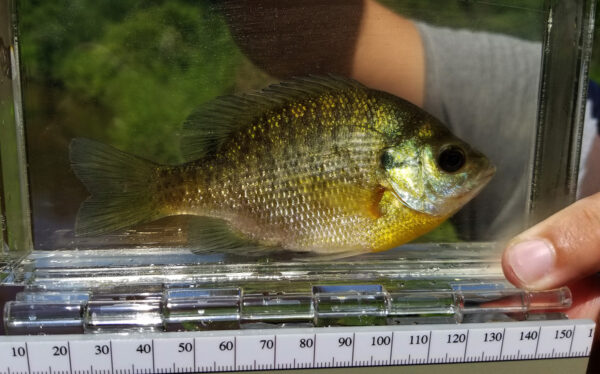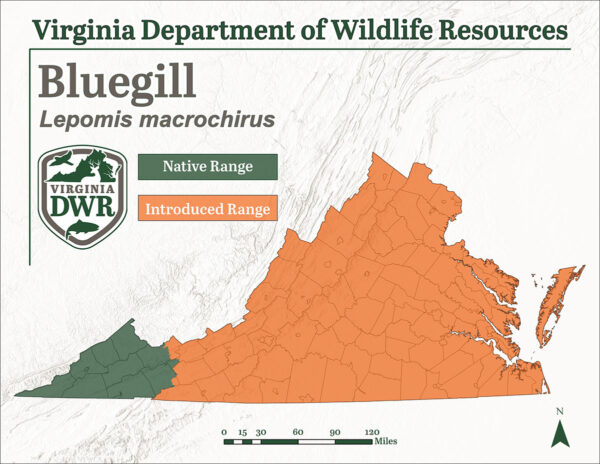A Bluegill being measured during a fisheries survey. ©Photo by Scott Herrmann
A Bluegill being observed in a holding tank. ©DCR Healthy Waters Program / VCU INSTAR
Fact File
Scientific Name: Lepomis macrochirus
Classification: Fish, Order Perciformes, Family Centrarchidae
Identifying Characteristics

A Bluegill being observed in a holding tank. ©DCR Healthy Waters Program / VCU INSTAR
- Round body shape with spinous front dorsal leading into a soft rear dorsal fin
- Lower portions of the gill plate are blue
- A solid black ear flap extending from the gill plate
- Several vertical bars extend down the side of the body
- Colors are variable but Bluegill are often olive-green, olive brown, or bluish-black on its back, fading to yellowish- green or silver
- A black splotch can be found near the back of the dorsal fin, near the base
Diet
Bluegill are generalist feeders, consuming anything they can catch. This most often includes insects, small crustaceans, worms and smaller fish.
Distribution:
Bluegill are found throughout Virginia as they are a popular species to introduce as a forage base for other recreational species. Within Virginia, they are native to the upper portions of the Big Sandy, Clinch, Holston, Powell, and Tug watersheds in the southwest portion of the state.

Habitat
Bluegill are habitat generalists, allowing them to occupy practically any warmwater environment in Virginia. Like other species of sunfish, they prefer underwater structure in the form of wood or submerged vegetation.
Reproduction
Bluegill begin to spawn in early summer in Virginia when water temperatures range from 70° to 75°F. Bluegill are prolific spawners, and will spawn multiple times throughout the summer at lower latitudes. Males sweep out dish shaped nests for females to deposit eggs for fertilization. Males become aggressive in defending nesting sites and will instinctively strike anything that intrudes upon its territory.
Last updated: April 10, 2024
The Virginia Department of Wildlife Resources Species Profile Database serves as a repository of information for Virginia’s fish and wildlife species. The database is managed and curated by the Wildlife Information and Environmental Services (WIES) program. Species profile data, distribution information, and photography is generated by the Virginia Department of Wildlife Resources, State and Federal agencies, Collection Permittees, and other trusted partners. This product is not suitable for legal, engineering, or surveying use. The Virginia Department of Wildlife Resources does not accept responsibility for any missing data, inaccuracies, or other errors which may exist. In accordance with the terms of service for this product, you agree to this disclaimer.

